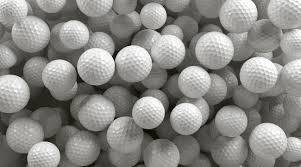The golf ball in play
The golf ball in play

It has become common practice in tournaments to announce the brand, type and number of the ball before the first tee. As soon as the ball can be changed according to the rules, this information should also be passed on to the other players. This procedure is a question of etiquette and not of rules. This practice becomes significant when a ball lands in the rough and must be searched for and correctly identified. A corresponding announcement is also common when a player, after a missed shot, hits a provisional ball behind. [3]
Physics
Dead water (light) is larger with a smooth surface (top).
Flight path of a golf ball with cw = 0.4, 0.1 and 0.0
The trajectory of a golf ball is determined by the weight and aerodynamic forces.
The angle of the club head (loft) causes the ball to rotate when hit, which contributes to the necessary directional stability during flight. Each golf shot triggers a backspin, provided the ball is hit with the club face. The different flight paths are triggered by additional lateral rotations.
The dimples on the ball surface reduce the drag coefficient (cw) by lowering the pressure resistance and reduce the drag by up to 50%. Depending on the stroke technique of the player, a golf ball can fly up to four times further [4].
The diameter and velocity of a golf ball are so small that the small Reynolds number suggests a laminar boundary layer flow. Small turbulences within the dimples change the laminar boundary layer around the ball into a turbulent boundary layer. The flow is delayed and thus reduces the volume of the dead water zone. A negative pressure prevails in this area. The smaller the zone, the smaller the pressure difference to the upstream side and thus the deceleration in flight direction. The mode of operation of turbulators on the wings of small aircraft is based on the same principle. The diagram shows the influence of air friction on the flight distance. At a teeing off speed of 80 m/s (very good player) a golf ball would fly more than 600 m without air friction (cw = 0). Without dimples the cw-value is about 0.4, which corresponds to a striking distance of 150 m. With dimples (cw = 0.1) it increases to more than double this value.
There are hundreds of different dimple patterns that are developed by the respective manufacturers of golf balls [5].
Golf balls are elastic. Due to the so-called smash, they store energy when touching the club, which they release again when hitting the ball. The Smash helps to increase the speed of the ball. Good golfers reach ball speeds of 250 km/h (70 m/s), the record is 328 km/h (91 m/s).
